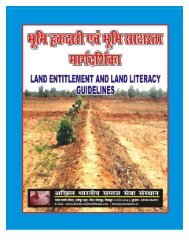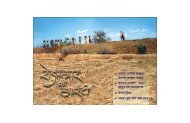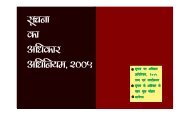Value chain study of income from trees and herbs - ABSSS
Value chain study of income from trees and herbs - ABSSS
Value chain study of income from trees and herbs - ABSSS
You also want an ePaper? Increase the reach of your titles
YUMPU automatically turns print PDFs into web optimized ePapers that Google loves.
<strong>Value</strong> <strong>chain</strong> <strong>study</strong> <strong>of</strong> <strong>income</strong> <strong>from</strong> <strong>trees</strong> <strong>and</strong> <strong>herbs</strong><br />
Income generation per item <strong>of</strong> produce<br />
As already mentioned, a very elementary value <strong>chain</strong> is followed for getting <strong>income</strong> <strong>from</strong><br />
<strong>trees</strong> <strong>and</strong> <strong>herbs</strong>. The produce is collected <strong>and</strong> sold, locally, usually through middlemen.<br />
No nutrients are provided to <strong>trees</strong>/<strong>herbs</strong> <strong>and</strong> no efforts are made to control pest <strong>and</strong><br />
diseases. No processing <strong>of</strong> produce is done. Moreover, except for some mango <strong>and</strong> ber<br />
saplings, no tree saplings have been planted, to increase <strong>income</strong> <strong>from</strong> <strong>trees</strong>. Overall, one<br />
can say that while a large number <strong>of</strong> <strong>trees</strong> <strong>and</strong> <strong>herbs</strong> in Project area have <strong>income</strong>generation<br />
potential, Project area HHs largely see these as supplemental sources <strong>of</strong><br />
<strong>income</strong>, with main soures <strong>of</strong> <strong>income</strong> being agriculture, labour or migration. This is also<br />
evident <strong>from</strong> the average <strong>income</strong> gained by HHs <strong>from</strong> different <strong>trees</strong> <strong>and</strong> <strong>herbs</strong>, as<br />
discussed below.<br />
Income <strong>from</strong> mango <strong>and</strong> ber<br />
Mango <strong>and</strong> ber <strong>trees</strong> that are richly laden with fruits are “sold” to middlemen, who collect<br />
the entire produce at their own cost. The price obtained for selling collection-rights in one<br />
season per fruit-laden ber tree varies <strong>from</strong> Rs 300 to 500. This is based on the fact that a<br />
mature <strong>and</strong> healthy ber tree that is over 15-years-old yields around 75 to 200 kg <strong>of</strong> fruit,<br />
<strong>and</strong> the price given to farmers by middlemen for ber fruit is Rs 3-4 kg. In a good year, a<br />
farmer with four healthy ber <strong>trees</strong> can thus earn around Rs 1500 to Rs 2000 <strong>from</strong> “sale”<br />
<strong>of</strong> <strong>trees</strong>. Farmers with less yielding or lesser number <strong>of</strong> <strong>trees</strong> sell the produce to<br />
middlemen or in the local market for Rs 3-4 per kg. The ber is sold after it is collected<br />
<strong>and</strong> sun-dried for a few days. Average <strong>income</strong> <strong>of</strong> HHs selling ber is around Rs 1200 per<br />
season.<br />
Collection rights for mature mango <strong>trees</strong> are sold at the rate <strong>of</strong> Rs 5000-6000 per tree.<br />
The pricing is based on fact that a mature tree yield around 500 kg, <strong>and</strong> per kg price paid<br />
by middleman is around Rs 10. While a few farmers earn over Rs 10,000 <strong>from</strong> mango<br />
produce in this way, the majority sell it in small lots to middlemen or in local markets.<br />
Average <strong>income</strong> per HH selling mango is around Rs 3600 per season.<br />
Income <strong>from</strong> mahua<br />
While mahua flowers as well as fruit (seed) have sale value, in the Project area only<br />
mahua flowers are collected <strong>and</strong> sold in large volumes. Relatively few HHs collect<br />
mahua fruit <strong>and</strong> depulp it to obtain seed. Even this activity is done mainly to obtain oil<br />
for home consumption.<br />
Whole families are involved in mahua-flower collection. Depending on the age <strong>and</strong><br />
health <strong>of</strong> a tree, it yields 10-300 kg <strong>of</strong> flowers. Most <strong>trees</strong> in Project area are said to be<br />
over 60 years old, with yield <strong>of</strong> over 200 kg <strong>of</strong> flowers. However, there are huge<br />
fluctuations in annual yield. A low-rainfall year, it is said, is followed by low mahua<br />
flowering. Further, flash rains with lightning in summer completely stops flowering (this<br />
happened in Project area in 2012 summer). Flowers lose 50-75% weight after drying.






